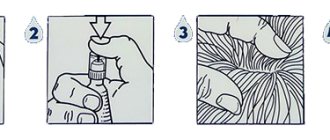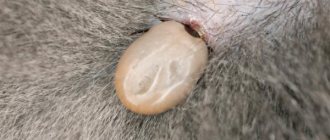Content
- When to start using anti-tick drops for dogs
- Mechanism of action
- Tick drops for dogs - TOP 15 best
- How to use anti-tick drops for dogs
- Restrictions when applying anti-tick drops to the withers
- Safety when using drops against ticks and fleas
- As recommendations
All pet owners in the spring are faced with the problem of choosing means to protect their pets from ticks. This is especially true for dog owners, because ticks carry very common and dangerous diseases, such as babesiosis (also known as piroplasmosis), borreliosis (the so-called Lyme disease, which can also affect people) and some others.
These diseases are much easier to prevent than to treat, so it is easier and cheaper to buy special acaricides at a pet store or veterinary pharmacy. Today, a huge number of drugs have been developed, varying in price and effectiveness, in the form of drops, collars, sprays and even tablets for systemic action against ticks. The validity period can vary from 1 week to 3 or more months.
Learn more about the habitats, external signs, developmental and behavioral characteristics of the tick, and how the infection process occurs.
In this material we will look at drops on the withers against ticks for dogs:
- when to start dripping drops;
- how these drugs work;
- composition, characteristic features and duration of protective action (briefly);
- restrictions and security issues, etc.
Anti-tick tablets
Tablets are probably the most effective way to protect against ticks, but you need to give preference to well-known brands in order to avoid poisoning. They are produced in the form of aromatic pieces that resemble delicacies. The dogs eat the pill with pleasure.
The required dosage, depending on the weight of the dog, is given during meals, either by adding it to a bowl of food or by feeding it by hand. It is not recommended to take tablets on an empty stomach.
Usually activated 30-60 minutes after consumption, the effect is quite long. The dog can be bathed, this does not affect the effectiveness in any way.
Unlike all of the above methods of fighting ticks, tablets do not have a repellent effect. That is, they begin to act only after the bite. It is necessary to accurately calculate the dog's weight in order to calculate the dosage and not cause unnecessary toxic effects. The drugs rarely cause allergies, but there may be side effects (weakness, vomiting, drooling, etc.).
Advantages
- Ease of use
- Safety for the animal
- Long-lasting protection and infection prevention
- Convenient dosage for all sizes of pets
- The most effective and efficient way to protect your pet from ticks
Flaws
- High price
- It is necessary to correctly calculate the dose for your pet, otherwise it may become poisoned
- It is forbidden to combine with other drugs
Mechanism of action
After applying drops to the dog’s skin, the active components are quickly distributed over the surface of the body, retained in the lipid layer on the animal’s skin and fur. The active substance is distributed throughout the dog’s body, protecting the entire surface of the animal’s body, including the most vulnerable places (the inner surface of the ears, armpits, between the paw pads, abdomen, groin area). After application, the active substances are distributed over the surface of the body within 24 hours, are not absorbed into the bloodstream, accumulate in the epidermis, hair follicles, sebaceous glands and have a long-term contact effect.
Tick drops for dogs also have a repellent effect on parasites and prevent the bite itself. The parasite gets on the dog's fur, but cannot gain a foothold. After such an interaction, the parasite falls from the animal and dies in the environment before it has time to bite the pet.
How to Apply Flea and Tick Drops for Dogs
Types of funds
Humanity has been fighting parasites for a long time and persistently, and today there are a lot of anti-tick remedies for dogs. There are tablets, drops, collars, sprays. There is also a wide range in price category. But I don’t want to save money, but to find the best tick repellent for dogs and protect my pet and myself. Dogs, even after one walk, can carry dozens of ticks. They really like them.
You can protect your dog using modern or traditional methods, but remember that no remedy can provide a 100% guarantee. Many people combine several different means. But there is danger here. It's best to consult your veterinarian.
Do not use different products, but based on the same substance. This may result in an overdose. Don't use all the remedies at once. It is better to allow some time between treatments. Try to keep track of processing dates. Each product has its own expiration date, but experienced dog owners know that you can safely subtract 5-7 days from the monthly period, because the effect is already running out and the ticks begin to cling. Even one missed day can be decisive. Make it a habit to process on the same date or mark it on your calendar.
Repellents and poisons act completely differently. Repellents repel parasites, but do not kill them. Poisons, on the contrary, kill parasites, but do not repel them. And they don’t do it instantly. A tick can latch onto a dog and crawl along it, slowly coming into contact with the poison. But he can still manage to bite. Therefore, after a walk, it is important to EXAMINE THE DOG and brush it. After every walk. Don’t be lazy, no matter how you treat it, a simple inspection is the surest remedy. This way you will detect the reptile quickly and be able to take prompt action.
What types of anti-tick products are there for dogs: drops, shampoos, collars, vaccinations, tablets, sprays. They all work differently. The effect of some lasts six months, while others last 12 hours. They also differ in toxicity; contact with mucous membranes and contact with other animals must not be allowed in the first 24 hours.
Toxicity is generally a separate issue. Despite the fact that manufacturers claim that the product is absolutely safe, it is still a chemical. Do not take cheap analogues, only a proven and well-known product. Even if you overpay a certain percentage for the brand, large companies still value their reputation and try to do everything with high quality. In this case, you save along with money for the health of your shaggy friend. But beware of fakes. Buy from trusted places. Once you find a dead or living tick on your dog, you cannot simply throw it away. It must be drowned in alcohol or burned. Otherwise he is still dangerous.
Anti-tick drops
Drops are applied to the withers. Thus, the animal cannot reach the treated area. But make sure that other animals do not lick the drug. How do the drops work? The drug is applied to the withers and is absorbed, entering the sebaceous glands. The drug accumulates and also comes back out. The drops act on the contact-intestinal principle, which means they do not repel parasites, but kill them. But the tick is still alive for some time, so it may well have time to bite, and although the poison has a paralyzing effect, it still happens.
The drops begin to act some time after application. Therefore, read carefully and most importantly follow the instructions. Pay attention to contraindications. The dog should not be washed several days before and after treatment. You need to wash with shampoos as little as possible. Along with the dirt, you wash away the protective layer and it will take several days to restore it. You can swim in ordinary water, but only if the drug is resistant to water. Dosages are indicated on the packaging. If this indicator is not there, do not take this product. You need to drip onto the skin, spread the fur. Don't try to pour as much as possible into one place. Distribute in places where the dog cannot lick them.
Which drops are better:
There are now many anti-tick medications, but you need to choose one of high quality. Pay attention to everything: the label, any contraindications, dosage, active substance.
- Frontline. An effective product that has been on the market for quite a long time. AB - fipronil. Sold in pipettes with different dosages for animals of different weights. Can be used to treat puppies over two months of age, suitable for pregnant women. Valid for 1 month.
- Practically tick. AB - pyriprole. Valid for a month. Suitable for puppies over two months old and pregnant dogs. But it is not used to treat dogs less than 2 kg.
- Advantix. Contains several ABs - permethrin and imidacloprid. Not only kills, but also has a deterrent effect. The parasite dies within 48 hours.
Anti-tick collar for dogs
Collars work the same way as drops. The substance from the tape gets onto the skin and spreads throughout the body. But unlike the first ones, they do not penetrate so deeply and therefore the collar must be worn constantly. After putting it on, you need to wait a couple more days until the active substance is distributed throughout the body. Collars last longer. The average period is 6 months. But as in the case of drops, it must be changed before the date specified by the manufacturer. The collar should make contact with the skin, but do not tighten it too tight - it should fit two fingers. For dogs with fluffy hair, it may be worth choosing a different product, as the hair will interfere with contact.
Sometimes the collar can cause an allergic reaction. The dog should be taken to a veterinarian and consulted about the selection of other means of protection. There are three types of collars: chemical, biological and ultrasonic. The latter are very rarely used: they are expensive and ineffective. Chemical collars kill parasites, but are more toxic. Biological ones are not so dangerous, but only repel ticks.
- Kiltix. Activation of the substance occurs after a day. Valid for six months. Not suitable for puppies, pregnant or lactating dogs.
- Skalibor - Suitable for pregnant dogs and puppies up to seven months of age. Helps not only against ticks, but also against fleas.
- Hartz. Collar from German manufacturers. Suitable for puppies of any age and has one of the lowest rates of allergic reactions.
Anti-tick spray for dogs
Sprays are instantly activated, but do not last so long. It is very difficult to spray, it is easy to get on mucous membranes. Treat your dog only outside and do not let him lick himself. Sprays rarely indicate the dosage, so choose those companies that have this indicator. Also, do not buy products that do not list the active ingredient. But still, it is better to combine sprays with other types of protection. It is usually used by those who rarely go outdoors. Or used as an additional measure of protection, for example, for paws that are washed constantly.
- Bolfo. Sprays against hair growth. Not for use on dogs under 6 months of age. The spray should be sprayed at a distance of 30 cm.
- Leopard. Spray from a Russian manufacturer. One of the cheapest, but still effective. Not very toxic.
- Frontline. Suitable for dogs of all ages and pregnant animals, but toxic to humans.
Anti-tick tablets for dogs
Tablets have become popular not so long ago. They have a number of advantages: they are non-toxic and can be given to nursing and pregnant dogs and puppies. There is no need to constantly use them like other means. Convenience and safety for humans.
- Frontline. AB - afoxolaner. Non-toxic, dog can be washed. It works quickly. The dosage depends on the dog's weight.
- Comfortis. AB - spinosad. Can be given to puppies from 4 months.
Tick vaccination for dogs
Vaccination is a more radical remedy. However, it still does not give 100% guarantees. The vaccine contains the virus, but it is weakened. Thus, the dog’s body begins to produce antibodies. There are two aspects of vaccinations that negate all their usefulness.
The tick still bites. And the animal becomes ill with paraplasmosis. It just tolerates it more easily and has a longer incubation period. But the animal still gets infected! Another disadvantage is that the symptoms are weaker. There are no pronounced symptoms due to the mild course of the disease. And late appeal is fraught with consequences.
Folk remedies for ticks for dogs
Previously, there were no vaccines, pills or collars. However, caring owners still managed to help their pets. Folk remedies do not contain chemicals and are safer, suitable for all dogs. But their lifespan is short, literally 2-3 hours and they need to be applied again. They act as a repeller, so the tick can still bite the dog.
What repels ticks? Wormwood decoction, vanilla tincture, tar water, garlic tincture, almond essential oil with geranium essential oil. The products are applied using a spray bottle or rubbed into the coat. In the case of garlic, apply the product only to those areas that the dog cannot reach.
Tick drops for dogs - TOP 15 best
In 2021 The following drops – preparations – are registered and used in Russia:
- "Frontline" (2 drugs - "Frontline Combo" and "Frontline Spot On" ), France
- Bravecto Spot On , USA
- "Dana-Ultra" , Russia
- Advantix , Germany
- "Lawyer" , Germany
- Hartz Ultra Guard , USA
- "Inspector" , Germany
- Biospotix Spot On , Germany
- "Prac-tik" / "Prac-tik" , Germany
- Rolf Club 3D , Germany
- "Insectal" , Germany
- "BEAPHAR - IMMO Shield Line-on" , Netherlands
- BEAPHAR - VETO pure , Netherlands
- " Bars " (2 drugs "Bars" and " Bars Forte" ), Russia
- Dironet Spot-on , Russia
- "Deltsit" , Russia.
| 1. “Frontline” (“Merial”, France) Active ingredients: a) “Frontline Combo” - 2-component ( fipronil 9.8%, S- methoprene 8.8% and excipients polyvidone and polysorbate). b) “Frontline Spot On” - d/v fipronil . The period of protection is from ticks – up to 4 weeks, from fleas and immature stages of fleas – up to 12 weeks, from the preimaginal phases of insect development – up to 8 months. | |
| 2. “Bravecto Spot On” (“Merck Animal Health” / “MSD Animal Health”, USA) The active ingredient is fluralaner . The period of preventive protection is up to 12 weeks. The speed of initial action is after 8 hours for fleas, after 12 hours for ticks. | |
| 3. “ Dana-Ultra” (Apicenna / Apicenna, Russia) Active ingredients - fipronil, thiamethoxam, pyriproxyfen. Destruction of external parasites, including fleas, lice and lice, within 24 hours after application of the drug. Protection against ixodid ticks for a month, against fleas, lice, lice for up to 8 weeks. Lack of resistance of parasites to the drug. Interruption of the development cycle of insects at the larval stage. | |
| 4. “Advantix” (“BAYER”, Germany) Active ingredients - imidacloprid 10% and permethrin 50%. The protection period is up to 28 days after a single application, if necessary, the frequency of treatments is no more than 1 time per week. Initial exposure time: 12 hours for fleas, 24 hours for ticks. | |
| 5. “Advocate” (“Bauer HealthCare AG”, Germany) Active ingredients - imidacloprid 10% (from external parasites - lice, adult fleas, flea larvae) and moxidectin 2.5% (from scabies mites - subcutaneous and ear mites, as well as for internal parasites – for roundworms). The validity period is up to 28 days after a single use. | |
| 6. “Hartz Ultra Guard” (“Hartz”, USA) Active ingredient – phenothrin 85.7% Protection period – up to 30 days after a single use, mandatory number of treatments – 3 times (once a month). The speed of initial action is from 15 minutes against mosquitoes, the full protective effect develops 2-3 days after application. | |
| 7. “ Inspector” (“Neoterica GmbH, Germany) Active ingredients – fipronil – 10% and moxidectin – 2.5%. Duration of protective action: against ticks 1 month, against insects 1.5 months, helminths 1 month. | |
| 8. “Biospotix Spot On” (Germany) Active ingredient – geraniol 0.75%, a herbal preparation. The period of action is up to 4 weeks after a single use. | |
| 9. “Prac-tik”/ “Prac-tik” (“Klocke Verpackungs-Service GmbH”, Germany) Active ingredient – pyriprole 125 mg/ml. The protective effect is 4 weeks, the speed of the initial effect is 24 hours. | |
| 10. "Rolf Club 3D" (Neoterica GmbH, Germany) Active ingredients - fipronil 9.8%, D- cyphenothrin 5.2%, pyriproxyfen 2%. Duration of protective action: up to 1 month - against ixodid ticks, 2 months - against fleas, lice, lice, 7 days - against mosquitoes, mosquitoes, midges. If there are attached ticks and parasitic insects, their detachment and death occurs within 1-2 hours after treatment. | |
| 11. “Insectal” (“Neoterica GmbH”, Germany) Active ingredients - fipronil 10% (from fleas and ticks) and pyriproxyfen 2% (from flea larvae and other parasites, reduces the risk of re-infection). Duration of protective action: up to 30 days against ticks, up to 2 months against fleas. | |
| 12. “BEAPHAR - IMMO Shield Line-on”, (“BEAPHAR BV”, Netherlands) Active ingredient – dimethicone , 474 g/l. The period of protective action is up to 4 weeks, the period of initial exposure is 24 hours | |
| 13. “BEAPHAR - VETO pure” (“BEAPHAR BV”, Netherlands) Margosa extract 50 g/l, pyrethrins and pyrethroids 5 g/l Protective effect period - up to 4 weeks, initial exposure period - 24 hours | |
| 14. “Bars” (LLC “AVZ S-P”, Russia) - TWO drugs “Bars” and “Bars Forte” ). The active ingredients are fipronil 50 mg/ml, diflubenzuron 1 mg/ml and dicarboximide (MGK-264) 5 mg/ml. Protective effect - 1-2 months with a single treatment. | |
| 15. “Deltsit” (LLC “AVZ S-P”, Russia) Active ingredient: deltamethrin 4.0%. It is used not only to combat ectoparasites of animals, but also for disinfestation and decontamination of premises. |
How to Apply Insectoacaricidal Flea and Tick Spray for Dogs
How can you protect your dog from ticks?
There are several ways to protect dogs from ticks:
- After each walk (even a short one), thoroughly wash the animal’s paws and inspect the surface of the body, especially the sides, ears, armpits, muzzle and inner thighs.
- If you and your pet spend a lot of time outdoors (for example, you temporarily live in the country), arrange for him to be examined every 4 hours.
This is interesting!
It is a mistake to think that a tick bites a dog immediately after it lands on his body. These parasites move incredibly slowly. Several hours may pass from the moment it hits the fur to the bite. This is enough to conduct an inspection and save the pet.
- In your garden, regularly mow the lawn, promptly remove fallen leaves and trim bushes, limiting the potential habitat of parasites.
- The parasite must be removed from the animal’s skin immediately after it is detected. This will help avoid complications.
Collar
Don't know how to protect your dog from fleas and encephalitis or other ticks in the forest? Use an acaricidal collar. It is impregnated with a liquid that has strong insecticidal properties. This is the simplest and most accessible method of dealing with this problem. It's very easy to use. You just need to unpack and put it on, adjusting it to fit. The impregnation is released during wear. It covers the skin and fur of the animal, repelling parasites.
Before using a collar, it is very important to study the duration of its effect. This will allow you to promptly replace old and ineffective ammunition with new ones.
Photo from ecowatch.com
Its disadvantages include the fact that it:
- does not protect the animal 100% (therefore it is used simultaneously with other means);
- its impregnation does not reach the back of the case;
- may cause allergies.
Owners of 2 or more pets should abandon the collar. This is due to the fact that they can lick each other. As a result, the harmful substance will enter the animal’s stomach.
Some of the best collars are products from Foresto, Virbac Preventic, Hartz Ultra Guard and LSD Pet. When selecting such ammunition, consider the age of the pet.
Drops
Many dog breeders believe that the best flea and tick protection for dogs is drops. The thing is that such formulations provide an almost 100% guarantee, and the process of treating pets takes only a few minutes. It is enough to spread the fur in the withers area, drop the product onto the skin and rub it in a little. The drops begin to act 24 hours after treatment. They are distributed in glands and follicles. Chemicals do not penetrate into the blood and therefore do not cause allergies or poisoning.
Photo from elheraldodechihuahua.com
After treatment, the dog should not be bathed for 3 days, otherwise you will significantly reduce the effectiveness of this drug. As a rule, just one dropper of drops is enough for 1 month. Don't forget to carry out the next treatment on time.
There are several types of drops. Choose products taking into account the age, weight and other individual characteristics of the animal. Pregnant and lactating females, as well as puppies and small breed pets should buy products labeled “Eco”.
Some of the most popular drops are products from the following manufacturers:
- "Dana."
- "Celandine".
- "Leopard".
- "Frontline".
- Bayer.
- "Strong Hold".
Shampoos
Photo from knip-knap-hondenkapsalon.be
Shampoos for pets often contain acaricides, insecticides and repellents. It is these components that provide protection against parasites for about 1 week. Therefore, if you are looking for ways to protect your dog from ticks, you can opt for shampoo, but only as an auxiliary and not the main method. It helps representatives of small breeds especially well.
Shampoos must be used in cases where you go to an area that is saturated with ticks. But you should refuse them, even if you have recently treated your dog with drops.
Shampoos, Hartz and “Red Cat” help well.
Sprays
Do you have a large dog and want to know what is the best tick and flea control? Bolfo, FrontLine, Hartz, Beaphar sprays are suitable for them. They can be sprayed in just a few minutes over the entire body of the animal, while the effectiveness remains up to 30 days. The main thing is to make sure that the dog’s entire body is thoroughly treated and that the animal does not lick the drug until it dries completely.
Sprays are aimed at repelling various parasites. But they begin to act almost immediately after application, which is especially important when you need protection right now. Their disadvantages include toxicity. Before spraying, be sure to close the airways of both yourself and your pet.
Photo from dogway.ru
There should not be any particular difficulties with using sprays. Apply them only in fresh air, slightly lifting the fur.
Pills
Don't want to process animal hair? What is the best way to protect your dog from ticks in this case? An innovation in the field of quality pet care is tablets. Today they are considered the most effective remedy. These drugs are available with various flavoring additives. The dog will happily swallow a tablet containing pork, sausage or chicken and will be protected from parasites.
The composition includes special substances that, when mixed with plasma, circulate throughout the body for a long time. At the same time, the drug not only destroys external parasites, but also destroys other pathogens of dangerous diseases.
Photo from zoon.kz
The positive side of the tablets is their relatively “soft” chemical composition. They can be given to older dogs, puppies, and lactating or pregnant females.
There are two companies that produce tablets:
- "Bravecto" with fluralaner, one dose is enough for about 3 months.
- Frontline protects dogs of various breeds for 30 days, but is contraindicated for dogs that suffer from allergies.
Vaccination
You can protect your animal with vaccinations. Veterinary clinics now offer the Pirodog vaccine from the Intervet company.
But these compositions do not completely prevent tick bites, but help avoid serious complications and alleviate the severity of the disease if this happens. In addition, the effectiveness of vaccination fluctuates around 85%.
Photo from punjabkesari.in
The first vaccination can be done when the puppy is 5 months old. Vaccination is carried out in 2 stages, between which there is a break of 1 month. A repeat course may be prescribed, but it is only completed after 1 year. The main thing is that during this period no other types of vaccinations are carried out (with the exception of protection against leptospirosis and rabies).
The vaccine begins to act only after 3 weeks and remains effective for 6 months. But it in no way replaces other treatments with acaricidal agents and inspection after each walk!
How to use anti-tick drops for dogs
1.If desired, you can wash your dog 2-3 days before using the drops. Cosmetics partially wash out the lipid layer, which is necessary for distributing droplets over the surface of the dog’s skin and coat. Therefore, if you washed your animal with shampoo, it is better to wait 2-3 days and treat the dog with drops.
2. The drug is applied to places inaccessible to licking by animals: on the skin at several points in the back, between the shoulder blades or in the neck at the base of the skull in doses specified in the instructions for each specific drug.
* A wet-oil stain may appear on the fur within 24 hours after application.
** At the site of application of the drug, hair may stick together, itching and slight redness may occur, sometimes hair loss, and if ingested, increased salivation.
3. For the first 2-3 days after treatment, it is recommended not to bathe the dog and not allow it into natural bodies of water.
4. Do not forget to treat the dog monthly during the entire period of parasite activity. Before walking, for additional preventive protection, it is recommended to use an insectoacaricidal spray against ticks.
Methods of protection against ticks
Manufacturers offer a variety of products: collars, spray, shampoos... However, not all products are equally effective. Some will create only imaginary protection. Let's look at each product category separately.
Cloth
You can make the jumpsuit yourself or buy a ready-made one. A special feature of the models is the presence of traps. Usually the insects sit on the grass, then move onto the dog and crawl up to get to the head. Parasites do not know how to bypass obstacles or return down. As a result, the mites end up in the folds of the fabric, from where the owner removes them later. It is advisable to impregnate the traps with a spray to enhance protection.
The main disadvantage of clothing is the lack of a full guarantee. The tick can still climb onto your head. If the elastic bands are loosely attached, then it is possible that they will get on the body. But the traps really work. When choosing, give preference to bright, solid-color models. On such surfaces you will notice the “invader” faster.
Vaccine and pills
You always want to find a simpler and more effective way. Manufacturers decided to help us and developed a vaccine against piroplasmosis and protective tablets. Unfortunately, neither one nor the other has been widely used. Why?
The vaccine is not completely safe . The drug temporarily weakens the immune system. Re-infection is possible if the companion has already been sick. It is logical that many owners prefer more effective and safe means.
The tablets are toxins that are poisonous to both ticks and dogs. Substances from the gastrointestinal tract enter the blood and are distributed throughout the body. When an insect bites, it receives a portion of poison and dies before it can infect its companion. But I don’t really want to give my dog poison in this form.
Spray
The most powerful option. The spray begins to act instantly, so it is suitable for unscheduled processing. However, the product has a number of disadvantages. Firstly, the dog can inhale and get poisoned. It is especially dangerous to allow your companion and other animals to lick toxins from your fur. Cats often do this: they try to wash their neighbor in order to restore the natural smell. Secondly, these products have a long list of side effects. Thirdly, it is difficult to find the correct dosage, despite the advice of manufacturers.
If the dog is weakened, sick or pregnant, it is better to use safer means. The same goes for puppies. Among the reviews of the sprays, you can find sharply negative ones: owners talk about how their pets were poisoned after treatment.
Collars
Should you use insect repellent collars? Controversial issue. They have a limited range, so in the case of large dogs they may not be effective. Not all accessories provide a high level of protection. One of the most powerful is the Kiltix collar. The danger of its use is that it is also toxic to the animal.
Collars will perfectly complement the main protection, but if there is a threat, it is better to entrust the main role to another means. Try to change accessories earlier than the manufacturer recommends. The advice is relevant when there is a normal threat of infection, but in most regions, alas, insect control measures are not carried out.
Shampoos
Almost useless, since the repellent effect does not last long, and you cannot constantly wash the dog. Such shampoos dry out the skin more than usual, so other problems often arise. They cannot be used for comprehensive protection either: in the process, the fatty film that protects the epidermis from toxins is washed away.
Drops
A compromise option. The drops are relatively safe and quite effective. In most cases, it makes sense to buy just such a product. Gentle formulations are suitable for weakened animals. It should be taken into account that during bathing the product is washed off, so after a few days the treatment will have to be repeated.
The main disadvantage of drops is the possibility of stumbling upon fakes. Read the annotation carefully and pay attention even to the little things.
Restrictions when applying anti-tick drops to the withers
- The drugs are contraindicated for use in case of increased individual sensitivity to the components of the drug (consult a veterinarian)
- If it is necessary to use the drug for Collie, Bobtail and Sheltie puppies, due to the increased sensitivity of dogs of these breeds to drugs, treatment should be carried out under the supervision of a veterinarian.
- It is prohibited for use by patients with infectious diseases, weakened animals and puppies younger than N weeks of age (see drug) and/or weighing less than 1-2 kg.
- It is not recommended to take the drugs together with other insectoacaricidal agents.
Safety when using drops against ticks and fleas
All drugs considered are certified and registered in the Russian Federation. According to the degree of impact on the body, they are classified as moderately dangerous substances (hazard class 3 or 4 according to GOST 12.1.007-76), in recommended doses they do not have skin-irritating and resorptive-toxic, embryotoxic and teratogenic effects. If it gets into the gala, mild irritation is possible. The drugs are toxic to rabbits, bees, fish and other aquatic organisms.
In case of overdose, excessive salivation, muscle tremors, and vomiting are possible. In this case, the drug is washed off with water and detergent, and the animal is prescribed antihistamines and symptomatic therapy.
As recommendations
- The animal should not be petted for 24 hours and should not be allowed near small children.
- Do not wash or bathe the animal for 3 days before and after treatment, and do not apply the drug to wet or damaged skin.
- In order to prevent re-infestation with fleas, the animals' bedding is replaced or the floors of the premises are treated with any insecticidal agent.
- Repeated treatments are carried out according to indications, but not more than once every 3-4 weeks.
- It is advisable to treat all animals living together.
- Clearly calculate the dosage based not only on the weight of the animal, but also on the age and state of health.
- If you have any doubts regarding use, you should consult a veterinarian. doctor.
- Pay special attention to treatments in the warm season.
When choosing protection for your pet, you must take into account that ticks, typical for Russia, are often resistant to antiparasitic drugs developed and produced in Europe. In addition, European drugs are developed with an eye on the composition of parasites living in Europe, without taking into account the characteristics of the Russian parasitic flora. Owners of pets living in Russia are recommended to use modern domestically produced parasite remedies for their pets - for example, products from the Dana Ultra line: anti-parasitic collars, drops on the withers and sprays for treating fur from the leading Russian manufacturer Apicenna.
Video about the mechanism of action of drops against pests using the example of the active ingredients imidacloprid and moxidectin from the company Bauer, Germany (not an advertisement)
Why are ticks dangerous for dogs?
The danger of blood-sucking parasites is that they can cause infection with serious diseases. The moment of infection with some diseases does not occur at the moment of the bite, but several hours later. Therefore, when independently extracting a parasite, it is important to monitor the animal’s condition during the first days if it is not possible to contact a veterinarian. To do this, you need to study the symptoms of diseases transmitted by ticks, so that at the first signs of illness you can contact a veterinarian and take measures to save the animal.
The list of diseases transmitted by ticks includes neurointoxication (tick paralysis), borreliosis (Lyme disease), babesiosis (pyroplasmosis), ehrlichiosis, hepatozoonosis, spotted fever, tularemia, bartonellosis. Rarely, skin lesions, such as folliculitis and erythema, are observed after a tick bite. A large number of ticks on an animal's body can lead to anemia.
The greatest likelihood of catching a tick exists in dogs with long hair, long ears, and a tail.










